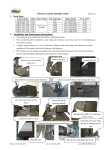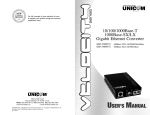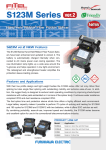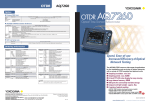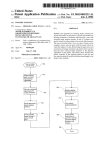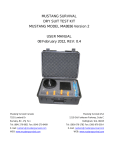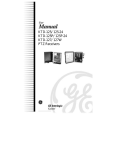Download fiber optic receiver contact installation and removal
Transcript
VIRGINIA PANEL CORPORATION FIBER OPTIC CONTACTS AND MODULES USER’S MANUAL: SECTION 1 FIBER OPTIC RECEIVER CONTACT INSTALLATION AND REMOVAL TOOLS REQUIRED 0.050” Allen Wrench Flat Head Screwdriver Phillips Screwdriver for iCon modules Mini Fiber Optic Extraction Tool, Part # 910 112 125 CONTACT INSTALLATION INSTRUCTIONS 1. 2. 3. Remove the dust cap from the VPC contact to be inserted. Insert the assembled contact into the back (wiring side) of the assembled module. The contact can only go into one side. Ensure that the contact is squared up with the corresponding module location. Once in place, pull the wire slightly to ensure that the contact is seated. Figure A. Module Cap Alignment Diagram. CONTACT REMOVAL INSTRUCTIONS 1. 2. 3. 4. 5. 6. Remove the module from the receiver frame. NOTE: For more information concerning the process of removing the module from the receiver frame, see module installation and removal instructions in Section 2 of this User’s Manual. Use the 0.050" Allen wrench to remove the module cap screws located at the top, middle and bottom of the module (Figure B). Grasp the module halves and apply force in opposite directions, rocking the ends of the module slightly while pulling the module cap away from the mating bottom section. Be sure to open both sides of the module simultaneously or contacts could be damaged. Place the Mini Fiber Optic Extraction Tool, part # 910 112 125 (Figure C), over the contact to be removed/replaced. Use care to keep the tool perpendicular to the surface of the module, otherwise the tool or contact could be damaged. Once the extraction tool is seated and the retaining ring tabs on the contact are compressed, push the tool into the module. The contact will be pushed out of the rear of the module. For 19 and 76 position modules, do not tighten screws. Insert an ITA contact in positions 2 and 18 or 2A and 18A (for 76 position modules) to properly align the module cap. With the ITA contacts in place, tighten the module cap screws. Do not over-tighten screws; screw torque limit is 13 +/- 1 in-oz. For all other modules, replace the module cap (Figure A) using both hands to push the separated halves together. Replace and tighten the module cap screws to a maximum torque of 2 in-lbs [0.23 Nm]. Figure B. Extraction Tool, Part # 910 112 125. DO NOT PUSH THE TOOL INTO THE MODULE UNTIL THE TIP OF THE EXTRACTION TOOL HAS BEEN FULLY SEATED INTO THE MODULE AND COMPRESSED THE RETAINING RING TABS ON THE CONTACT. NOTE: The process shown here uses standard/90 series modules. The same process is used for modules from other series. NOTE: If you are using a hybrid module, you may need to reference the User’s Manual for the other contact type for extraction instructions. WHEN HANDLING FIBER OPTIC CABLES DO NOT LOOK INTO THE ENDS OF ANY CONNECTOR. LASER LIGHT COULD CAUSE PERMANENT EYE DAMAGE. 1-1 Figure C. Be sure to keep the tool perpendicular so as to avoid bent pins. For more information, visit vpc.com 4/10/13 VIRGINIA PANEL CORPORATION FIBER OPTIC CONTACTS AND MODULES USER’S MANUAL: SECTION 1 FIBER OPTIC STRAIN RELIEF GUIDE TOOLS REQUIRED Receiver Strain Relief Plate, Part # 510 109 116/298 ITA Strain Relief Plate, Part # 510 109 296 FIBER OPTIC WIRE STRAIN RELIEF GUIDELINES 1. 2. Ensure that the bend radius exceeds the minimum bend radius of the fiber optic wire at all times. The minimum bend radius for the fiber optic wire is 15x the diameter of the cable (Figure A). Max Bend for 62.5/125µ or 62.5/125µ Multimode: 1.77” [45 mm] Max Bend for POF: 1.18” [30 mm] The bend radius minimum must be adhered to when tying down wires to the strain relief plate. Use two sets of wire ties for each wire. Take care not to crush fiber optic wire when cinching the wire tie. For receiver side wires, leave a slight amount of slack in the cable when securing them to the strain relief plate to allow the contacts to align when the modules are engaged (Figure B). BEND RADIUS (15x CABLE DIAMETER) Figure A. Minimum bend radius is 15x the diameter of the wire. USE TWO TIES PER WIRE. DO NOT CRUSH FIBER OPTIC CABLES WHEN CINCHING ZIP TIES FOR STRAIN RELIEF. A INNER PORTION OF RECEIVER SIDE CONTACTS MUST BE FREE TO MOVE DURING ITA ENGAGEMENT (DISENGAGED) DETAIL A SCALE 3 : 1 INNER PORTION OF RECEIVER SIDE CONTACTS MUST BE FREE TO MOVE DURING ITA ENGAGEMENT (ENGAGED) DETAIL B SCALE 3 : 1 Figure B. Use two wire ties for each wire. Make sure to cinch the ties loosely enough so the wire can move freely when the modules are engaged. WHEN HANDLING FIBER OPTIC CABLES DO NOT LOOK INTO THE ENDS OF ANY CONNECTOR. LASER LIGHT COULD CAUSE PERMANENT EYE DAMAGE. 1-3 For more information, visit vpc.com 4/10/13


